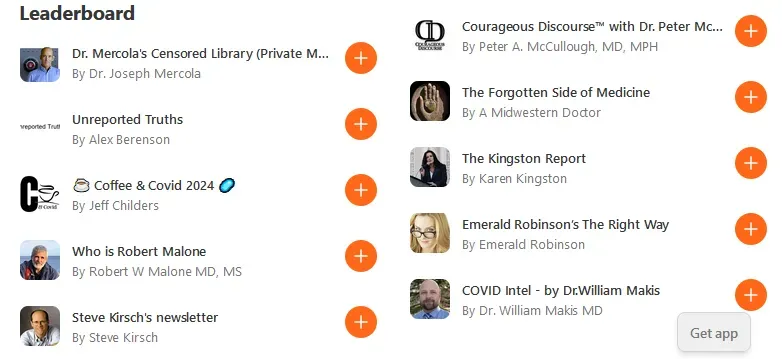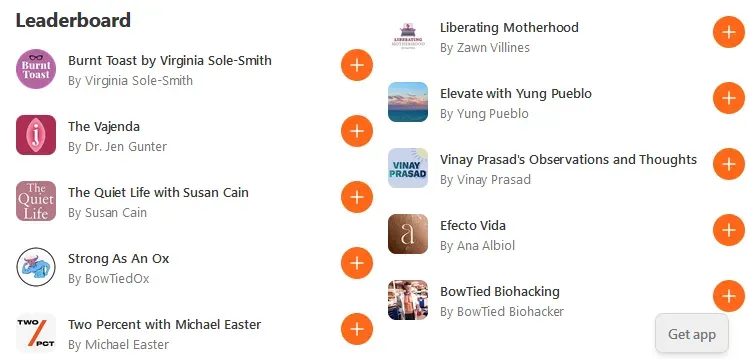The Ailing Health of the Substack Health Community

I like Substack a lot. I don’t know what I’d be doing as a writer during the sunset of social media if I hadn’t found the last platform on the internet that links writers up with each other and with potential audiences. The true community potential of the web, that you would think we’d want to nourish as a species, turned out to be a temporary fad that burned out as the link aggregators, one by one, calcified, enshittified, walled themselves up, and sank slowly into the Atlantic.
We are a literate species, driven by an urge to read and to communicate, but this fire that burns in our souls is only harvested to spin the turbines that generate wealth for one insufferable trillionaire or another. I’m a refugee of the old web and Substack is the last place where I can set up shop and have a chance of anyone seeing my work. So yes, I like it there.
That said, it has its oddly concentrated pockets of darkness. Like any social network it has an algorithm and no matter how well you curate and train your feed you will occasionally get a recommendation that pops its head out from the bad place, like a mouse turd in your bag of allsorts. I find myself getting rare but surprising and unexplained recommendations like this:

Often enough, I felt, that something is going on in whatever amounts to a health science community at this place. Something ripe for an apt health-associated metaphor—like a spreading contagion or, maybe better, an unchecked growth.
The most popular piece I’ve written at Substack is still The Hard Problem of Social Media in which I argued that the Holy Grail mission of any social platform with network effects is a political emulsion. It was written during the height of the controversy of Substack’s management refusing to make rules against white supremacist content on freedom of speech grounds.
But my piece wasn’t an advocacy for censorship—I wanted to be descriptive, not prescriptive, of the fundamental problem. I think I did well. The only person from any point in the political spectrum who really vocally hated it was Freddie DeBoer, but I honestly do not think he more than skimmed it and I’m not sure he’s ever liked anything.
My hypothesis is that platforms that attempt to embrace all content equally under the principle of free speech run into a natural migration problem in which one kind of content drives out another kind of content that doesn’t want to be associated with it. The content that overwhelms is what I call liquid content and the example I gave was pornography. In short, when you allow porn on your website without restriction, the people who don’t like being around a whole bunch of porn all the time flow out, leaving room for the porn (which will always flow toward wherever it's permitted to be) to flow in.
Pornographers don’t mind being around other people as much as other people don’t like being around porn, so the liquid content fills the shape of its container. Your site is now a porn site.

When I wrote that piece the liquid content I was analogising was white supremacy and it was a hypothetical about what might happen to Substack if this kind of content continued to proliferate, and although the Nazi-gate controversy of 2023 has blown over I think we are beginning to see the effects of a liquid content takeover of one corner of the Substack blogosphere.
Specifically—has anyone checked in lately on the health of the Health section?
Along with the vaguely Twitter-clone Notes feed that forms Substack’s home page and social network, the site also has a leaderboard and directory sorted by topic that also informs the algorithm that occasionally suggests articles to you on Notes. This suggestions pane is how I first became alerted to the fact that something a little troublesome was brewing in areas of the site I haven’t paid much attention to, so I slipped into the back alley.
There are 29 subject categories in Substack’s browse section, mostly the type of ones you would expect from a newsletter blogging platform—Finance, Food & Drink, Travel, Sports, Technology, etc. It’s missing some that you might expect (there’s no queer or LGBT category) and some seem redundant, but this isn’t about what I would do.


The leaderboards of these categories in general are impressively nonpartisan. US Politics, for example, shows a pretty balanced diet of views as diverse as Bari Weiss, Matt Taibbi, Medhi Hasan, Robert Reich, and Matthew Yglesias. The balance, I would say, leans to the right, but it’s hardly a Mar-a-Lago function or else Robert Reich is very lost. News leads with Michael Shellenberger’s right-wing Public but it’s not too many slots above Wonkette.
As much as I feared Substack’s moderation policies would turn it into Rumble for writers, it doesn’t feel like that’s happening, or it’s not happening quickly. Which is great news for people like me, who value freedom of speech but don’t use the term as a code for There’s Too Many Black People On TV.
Then you look at the Health Politics category.
Ten out of ten—one hundred percent—of the Substacks on the Health Politics leaderboard are hard line anti-vaccine newsletters. It is a narrow-focus, politically unanimous category.

We’re not talking about mild vaccine skepticism or corporate pharmaceutical accountability advocacy or whatever it is that Robert Kennedy Jr is or thinks or says he is. One of the most recommended articles in this category for days now is this interview with someone who claims Covid 19 does not and never did exist.

Dr Sam Bailey’s newsletter is a germ theory denial blog which pushes what the alt-science community likes to tout as “alternative theories” of disease that involve no foreign organism (ie. Viruses, bacteria, and parasites either do not exist or do not cause disease). These ideas, like terrain theory (all disease is the result of dietary, chemical, or energy imbalances) or miasma theory (disease is caused by bad smells) are alternative theories in the exact same way that flat earth theory is an alternative theory about the shape of the planet.
This type of quackery is liberally sprinkled around and throughout these blogs, many of which have titles like the “Censored Library” or “Unreported Truths” or “Courageous Discourse,” phrases that border on the absurd when thrown around by authors like Joseph Mercola, Alex Berenson, and Robert Malone, whose newsletters boast tens or hundreds of thousands of paying subscribers each, and make six digits a year—plausibly a good fraction of a million—from their newsletters alone.
This isn’t censored or unreported information. Based on these leaderboards, it’s the only information that a huge number of people are getting.

You would be right to pull me up here on the basis that this doesn’t represent the entire health community of Substack, and in fact, it is the one section of the community that is specifically labelled “Health Politics.” But this still puzzles me in a number of ways, for example: Why is the only way to talk about the politics of health to reject health science? I would think there are many aspects in which politics impacts health. Let’s talk about vaccine patents, let’s talk about insulin prices, let’s talk about public health policy. Crucial subjects about society and civilisation that are being drowned out by garbage about how measles is caused by loud noises and a bad colour scheme.
Why does this topic even exist as its own category, and if it is just the “alt medicine” or kook science activism counterculture then why not call it something like that? Why are these all bundled together and why can’t any more mainstream view at the intersection of health and politics break through? Is it some kind of quarantine measure?
A look at the Health & Wellness category leaderboard might restore some confidence:

There’s a mix here and it’s the type of stuff you’re more inclined to expect from the standard mainstream health blogosphere. I had a look through a number of these and I didn’t find anything nuts.
A few things do still stand out to me, though. One, this is a strongly female coded selection, it’s got a very women’s magazine in the waiting room vibe. Two, there’s not a lot of health science going on here. With the exception of the “Bow Tied Ox” which appears to be a muscle fitness blog, these lean heavy on wellness, mindset, and spirituality. Three, none of these people are making anywhere near Joseph Mercola money.
That’s the leaderboard of this section. Now let’s take a look at the recommended articles for this category this week:

Oh, hello reactionaries! I knew you’d be here somewhere! You were hiding in the algorithm!
While casual wellness might top the leaderboard here, no one piece in the category can top right wing outrage and anti-vaccine quackery on sheer numbers. Why not?
I reiterate, this is a phenomenon that only appears to affect health categories. The categories that are straight up labelled “politics” are much more measured and viewpoint heterogenous with the single exception of Health Politics. If the intersection of science and politics is itself the issue then you would absolutely expect the Climate & Environment category would be similarly rife with wall to wall global warming denial, but oddly enough, it just isn’t.

This stuff is undoubtably political! But it’s thought provoking, meaty discourse, in line with science. I’m sure there are probably tons of climate denial, woodchip the Amazon, hotbox CO2 and nuke the whales newsletters, it’s the mainstream view of a huge chunk of politics, but whatever forces drive extreme health misinformation to the forefront of that conversation in all related categories don’t seem to have the same effect on other political science issues.
I can’t say exactly what’s going on, but we have a blind spot in the design of our algorithms, and as we learned from Covid, the way that we disseminate and communicate proper informed health science in this day and age is a disaster.
The way that we have tried to handle health misinformation on other platforms, particularly during the pandemic, might be key to this. Obviously the fact that people like Joseph Mercola are easily able to reach a much larger audience than, for example, Paul Offit makes his complaints of silencing or censorship completely absurd, but our handling of this type of material through brute force platform moderation has enabled these quacks to give the impression that they’re censored. They can claim that they’re in the possession of rare and dangerous knowledge. And, as we know, scarcity drives demand, even artificial scarcity.
I want to reiterate that I’m not for censorship in general, and I’m not just saying this out of fear that Matt Taibbi might actually jump on a plane and come to my fucking house with a bat (the type that breaks my legs, not the type that spreads Covid [also he doesn’t believe that came from a bat, I think he’s a Lab Leak guy]). I don’t decry shutting down dangerous charlatans out of adherence to a principle or concern for their feelings, though—I do it because it doesn’t work. My suspicion about why this specific dumptruck load of garbage has landed on Substack is because it’s been “kettled” there. Forced to concentrate and intensify on the few websites whose moderation standards permit it to exist.
And far be it for me to criticise Substack here or call for harsher controls or censorship—you might be able to clean this house but the problem will move to another platform. You can’t get rid of this trash by hurling it over the neighbour’s fence. My complaint isn’t that this shit is in my backyard, it’s that it’s poisoning the groundwater from whatever yard it’s in.
What we need is better health communication and better algorithms to promulgate it. Not just rely on the almighty Marketplace for people to select what “facts” they want out of reality and line the pockets of whoever can make up the most comforting lie. We need to raise people up. We need Paul Offit to reach as many people as Joseph Mercola.
Our literal health depends on the health of our discourse, our science communication, and our algorithms.





